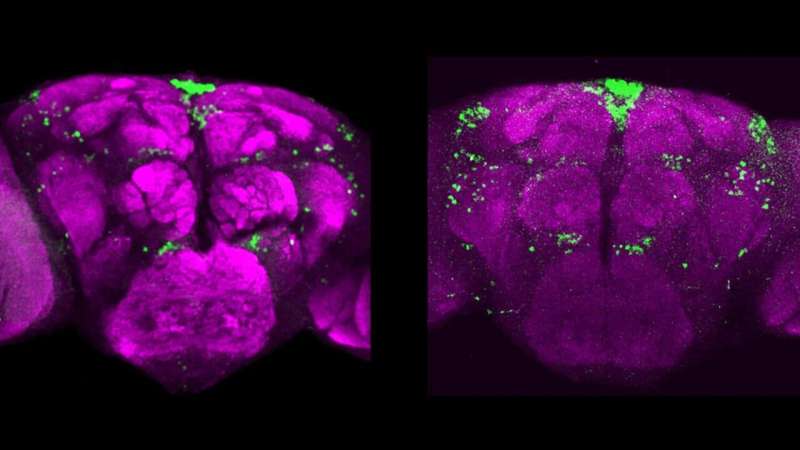This article has been reviewed according to Science X's editorial process and policies. Editors have highlighted the following attributes while ensuring the content's credibility:
fact-checked
peer-reviewed publication
trusted source
proofread
'Courtship' gene shows different effects in two fruit fly species

A gene associated with courtship behavior in fruit flies does not operate the same way in two different fruit fly species, a new study finds. The work demonstrates that conserved genes—the same genes found across species—do not necessarily have the same function across species.
Fruitless (fru) is a gene common to fruit flies and many other insect species. The gene is associated with male courtship behaviors. Scientists have studied the expression and function of the gene, specifically in Drosophila melanogaster (D. melanogaster), by either removing it from males or by giving it to females and observing the results. For example, males with fru removed lose some male-specific courtship behaviors, and females given fru gain some of those behaviors.
"The fruitless gene was first found in D. melanogaster, but it is conserved across species from grasshoppers to cockroaches and mosquitoes, and earlier experiments suggested that its function was also conserved across species," says Christa Baker, a former postdoctoral researcher at Princeton and now an assistant professor of biology at North Carolina State University.
"But researchers' genetic tools have advanced. With CRISPR-Cas9, we can now add fru to females of other species to see whether the gene functions the same way." Baker is a co-corresponding author of a paper describing the work.
Baker and the research team decided to look at the function of fru in a different fruit fly species, Drosophila virilis (D. virilis).
"D. virilis is quite divergent from D. melanogaster—the species split apart around 60 million years ago," Baker says. "So comparing these two fruit flies is like comparing a mouse to a rat. They're both fruit flies like mice and rats are both rodents, but they are very different."
Fruit flies have two copies of every gene, just like humans do. The researchers began by giving the D. virilis females one copy of fru and found that while they were about 40% less likely to mate, D. virilis females who did mate remained fertile. In contrast, while D. melanogaster females with one copy of fru are also about 40% less likely to mate, those who do mate can no longer lay eggs.
These findings point to a similar role for fru in some female behaviors, like mating, but a different role in other behaviors, including laying eggs.
"D. virilis is especially interesting because both males and females have mating songs," Baker says. "In most fly species, only the male sings. In D. melanogaster, giving females fru results in their adopting male courtship behavior, such as singing. But D. virilis females with one copy of fru retained the ability to sing the female's song, although they sang much more than females without fru."
The researchers then added a second copy of fru to the D. virilis females and saw that they were now able also to produce male songs; however, they retained the ability to produce female songs. Additionally, females with two copies were completely unreceptive to mating and tended to express aggression toward courting males.
"The canonical idea had been that giving females fru endows her with male behaviors while disrupting female behaviors like receptivity and egg-laying," Baker says. "Our findings in D. virilis are exciting because they show that giving fru to female D. virilis does enable her to sing male songs, but it does not prevent her from singing female songs."
"We don't know why two copies of the gene were needed in D. virilis females to produce results similar to those from one copy in D. melanogaster, but it opens up exciting new avenues for exploration," Baker adds.
"What it does tell us, though, is that just because a gene is conserved across species doesn't mean its function is also conserved. If we want to understand how our genome impacts behavior and development, we need to study genes' impacts across diverse species and behaviors."
The findings are published in the journal Science Advances.
More information: Christa A. Baker et al, The role of fruitless in specifying courtship behaviors across divergent Drosophila species, Science Advances (2024). DOI: 10.1126/sciadv.adk1273
Journal information: Science Advances
Provided by North Carolina State University





















